Case Study Analysis: Business and Corporate Law - LAW6000
VerifiedAdded on 2023/05/31
|7
|1588
|498
Case Study
AI Summary
This document presents a comprehensive analysis of three business law case studies. The first case examines the authority of partners within a partnership, specifically addressing express and implied authority, fiduciary duties, and the consequences of exceeding limitations on authority. The second case delves into the concept of unconscionability in contracts, focusing on the Australian Consumer Law and the factors courts consider when determining if a contract is unconscionable. The third case explores the validity of past consideration in contract law, differentiating between valid consideration and past consideration. Each case study includes an identification of the legal issues, relevant legal principles, application of the law to the facts, and a conclusive recommendation. The analysis references key legislation such as the Partnership Act of Australia and the Competition and Consumer Act, along with pertinent case law like Mercantile Credit Co Ltd v. Garrod, Commonwealth Bank v Amadio, and Roscorla v Thomas.
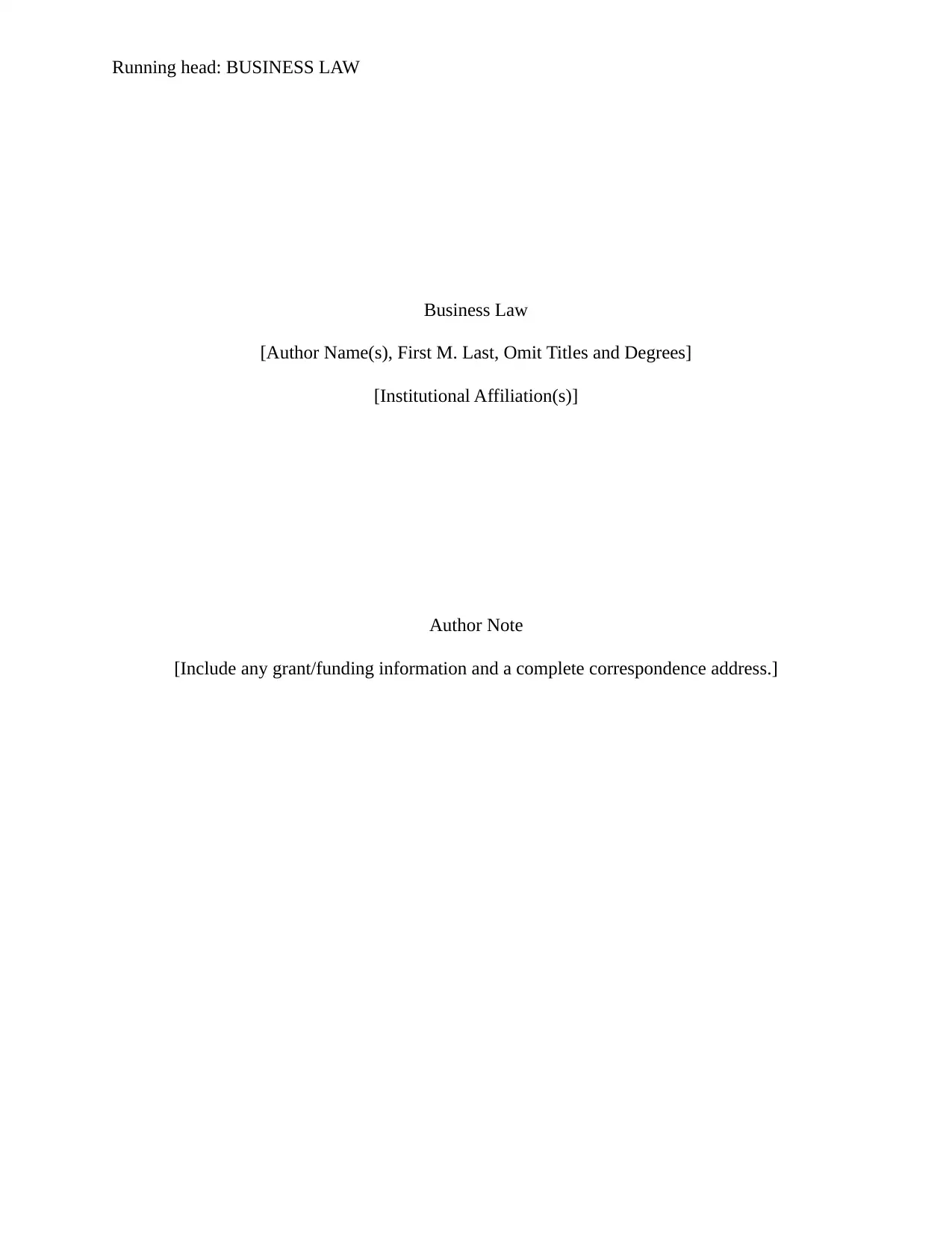
Running head: BUSINESS LAW
Business Law
[Author Name(s), First M. Last, Omit Titles and Degrees]
[Institutional Affiliation(s)]
Author Note
[Include any grant/funding information and a complete correspondence address.]
Business Law
[Author Name(s), First M. Last, Omit Titles and Degrees]
[Institutional Affiliation(s)]
Author Note
[Include any grant/funding information and a complete correspondence address.]
Paraphrase This Document
Need a fresh take? Get an instant paraphrase of this document with our AI Paraphraser
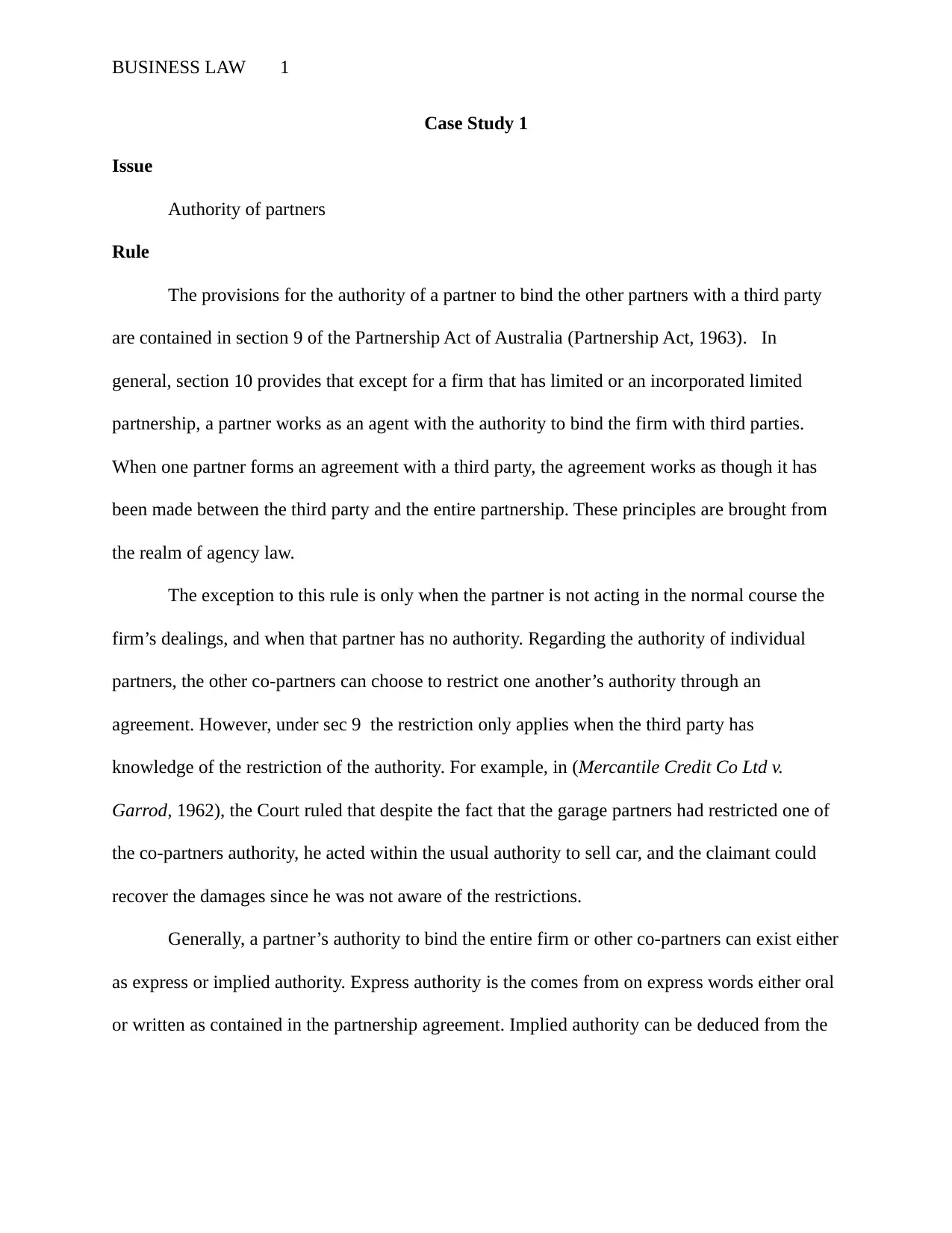
BUSINESS LAW 1
Case Study 1
Issue
Authority of partners
Rule
The provisions for the authority of a partner to bind the other partners with a third party
are contained in section 9 of the Partnership Act of Australia (Partnership Act, 1963). In
general, section 10 provides that except for a firm that has limited or an incorporated limited
partnership, a partner works as an agent with the authority to bind the firm with third parties.
When one partner forms an agreement with a third party, the agreement works as though it has
been made between the third party and the entire partnership. These principles are brought from
the realm of agency law.
The exception to this rule is only when the partner is not acting in the normal course the
firm’s dealings, and when that partner has no authority. Regarding the authority of individual
partners, the other co-partners can choose to restrict one another’s authority through an
agreement. However, under sec 9 the restriction only applies when the third party has
knowledge of the restriction of the authority. For example, in (Mercantile Credit Co Ltd v.
Garrod, 1962), the Court ruled that despite the fact that the garage partners had restricted one of
the co-partners authority, he acted within the usual authority to sell car, and the claimant could
recover the damages since he was not aware of the restrictions.
Generally, a partner’s authority to bind the entire firm or other co-partners can exist either
as express or implied authority. Express authority is the comes from on express words either oral
or written as contained in the partnership agreement. Implied authority can be deduced from the
Case Study 1
Issue
Authority of partners
Rule
The provisions for the authority of a partner to bind the other partners with a third party
are contained in section 9 of the Partnership Act of Australia (Partnership Act, 1963). In
general, section 10 provides that except for a firm that has limited or an incorporated limited
partnership, a partner works as an agent with the authority to bind the firm with third parties.
When one partner forms an agreement with a third party, the agreement works as though it has
been made between the third party and the entire partnership. These principles are brought from
the realm of agency law.
The exception to this rule is only when the partner is not acting in the normal course the
firm’s dealings, and when that partner has no authority. Regarding the authority of individual
partners, the other co-partners can choose to restrict one another’s authority through an
agreement. However, under sec 9 the restriction only applies when the third party has
knowledge of the restriction of the authority. For example, in (Mercantile Credit Co Ltd v.
Garrod, 1962), the Court ruled that despite the fact that the garage partners had restricted one of
the co-partners authority, he acted within the usual authority to sell car, and the claimant could
recover the damages since he was not aware of the restrictions.
Generally, a partner’s authority to bind the entire firm or other co-partners can exist either
as express or implied authority. Express authority is the comes from on express words either oral
or written as contained in the partnership agreement. Implied authority can be deduced from the
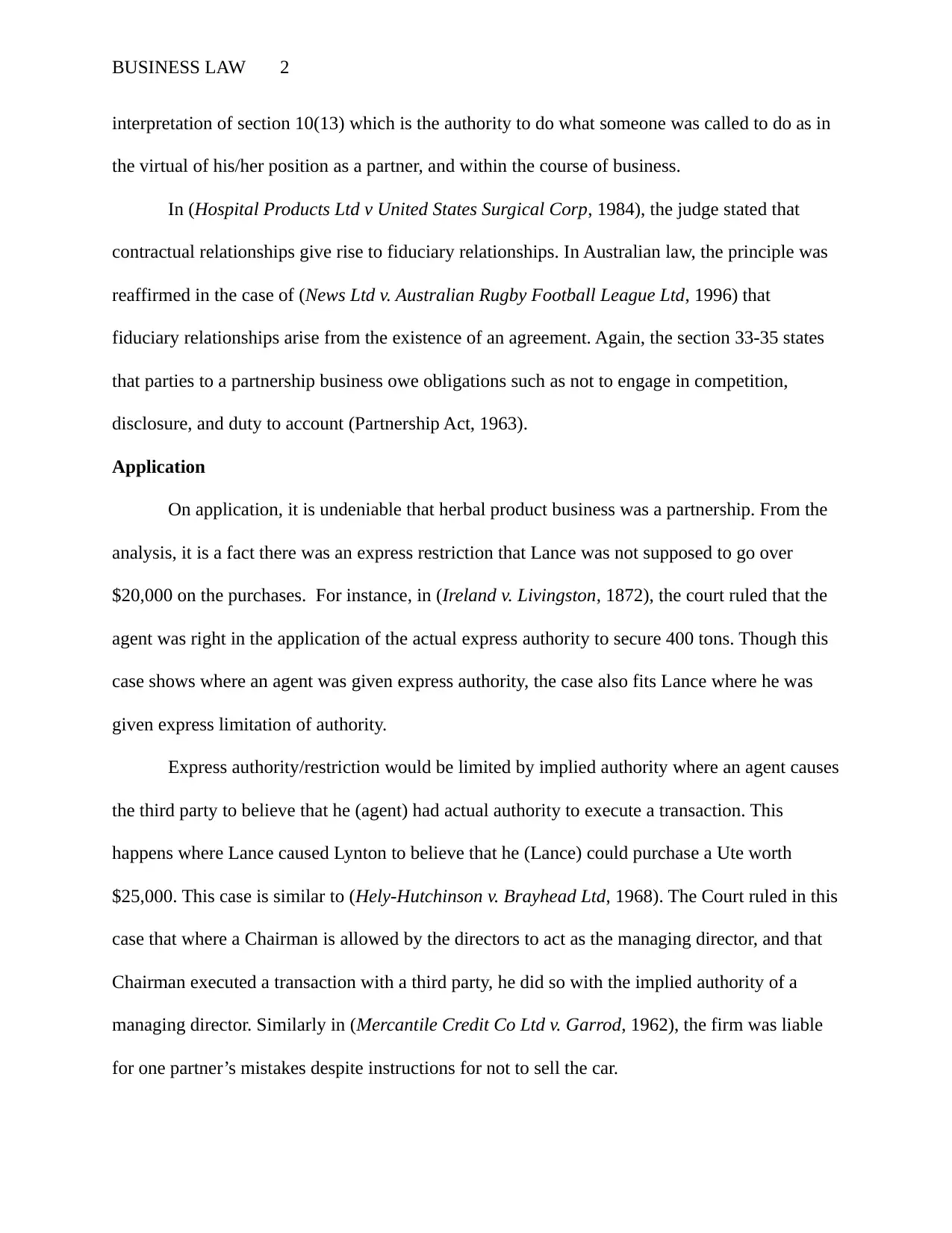
BUSINESS LAW 2
interpretation of section 10(13) which is the authority to do what someone was called to do as in
the virtual of his/her position as a partner, and within the course of business.
In (Hospital Products Ltd v United States Surgical Corp, 1984), the judge stated that
contractual relationships give rise to fiduciary relationships. In Australian law, the principle was
reaffirmed in the case of (News Ltd v. Australian Rugby Football League Ltd, 1996) that
fiduciary relationships arise from the existence of an agreement. Again, the section 33-35 states
that parties to a partnership business owe obligations such as not to engage in competition,
disclosure, and duty to account (Partnership Act, 1963).
Application
On application, it is undeniable that herbal product business was a partnership. From the
analysis, it is a fact there was an express restriction that Lance was not supposed to go over
$20,000 on the purchases. For instance, in (Ireland v. Livingston, 1872), the court ruled that the
agent was right in the application of the actual express authority to secure 400 tons. Though this
case shows where an agent was given express authority, the case also fits Lance where he was
given express limitation of authority.
Express authority/restriction would be limited by implied authority where an agent causes
the third party to believe that he (agent) had actual authority to execute a transaction. This
happens where Lance caused Lynton to believe that he (Lance) could purchase a Ute worth
$25,000. This case is similar to (Hely-Hutchinson v. Brayhead Ltd, 1968). The Court ruled in this
case that where a Chairman is allowed by the directors to act as the managing director, and that
Chairman executed a transaction with a third party, he did so with the implied authority of a
managing director. Similarly in (Mercantile Credit Co Ltd v. Garrod, 1962), the firm was liable
for one partner’s mistakes despite instructions for not to sell the car.
interpretation of section 10(13) which is the authority to do what someone was called to do as in
the virtual of his/her position as a partner, and within the course of business.
In (Hospital Products Ltd v United States Surgical Corp, 1984), the judge stated that
contractual relationships give rise to fiduciary relationships. In Australian law, the principle was
reaffirmed in the case of (News Ltd v. Australian Rugby Football League Ltd, 1996) that
fiduciary relationships arise from the existence of an agreement. Again, the section 33-35 states
that parties to a partnership business owe obligations such as not to engage in competition,
disclosure, and duty to account (Partnership Act, 1963).
Application
On application, it is undeniable that herbal product business was a partnership. From the
analysis, it is a fact there was an express restriction that Lance was not supposed to go over
$20,000 on the purchases. For instance, in (Ireland v. Livingston, 1872), the court ruled that the
agent was right in the application of the actual express authority to secure 400 tons. Though this
case shows where an agent was given express authority, the case also fits Lance where he was
given express limitation of authority.
Express authority/restriction would be limited by implied authority where an agent causes
the third party to believe that he (agent) had actual authority to execute a transaction. This
happens where Lance caused Lynton to believe that he (Lance) could purchase a Ute worth
$25,000. This case is similar to (Hely-Hutchinson v. Brayhead Ltd, 1968). The Court ruled in this
case that where a Chairman is allowed by the directors to act as the managing director, and that
Chairman executed a transaction with a third party, he did so with the implied authority of a
managing director. Similarly in (Mercantile Credit Co Ltd v. Garrod, 1962), the firm was liable
for one partner’s mistakes despite instructions for not to sell the car.
⊘ This is a preview!⊘
Do you want full access?
Subscribe today to unlock all pages.

Trusted by 1+ million students worldwide
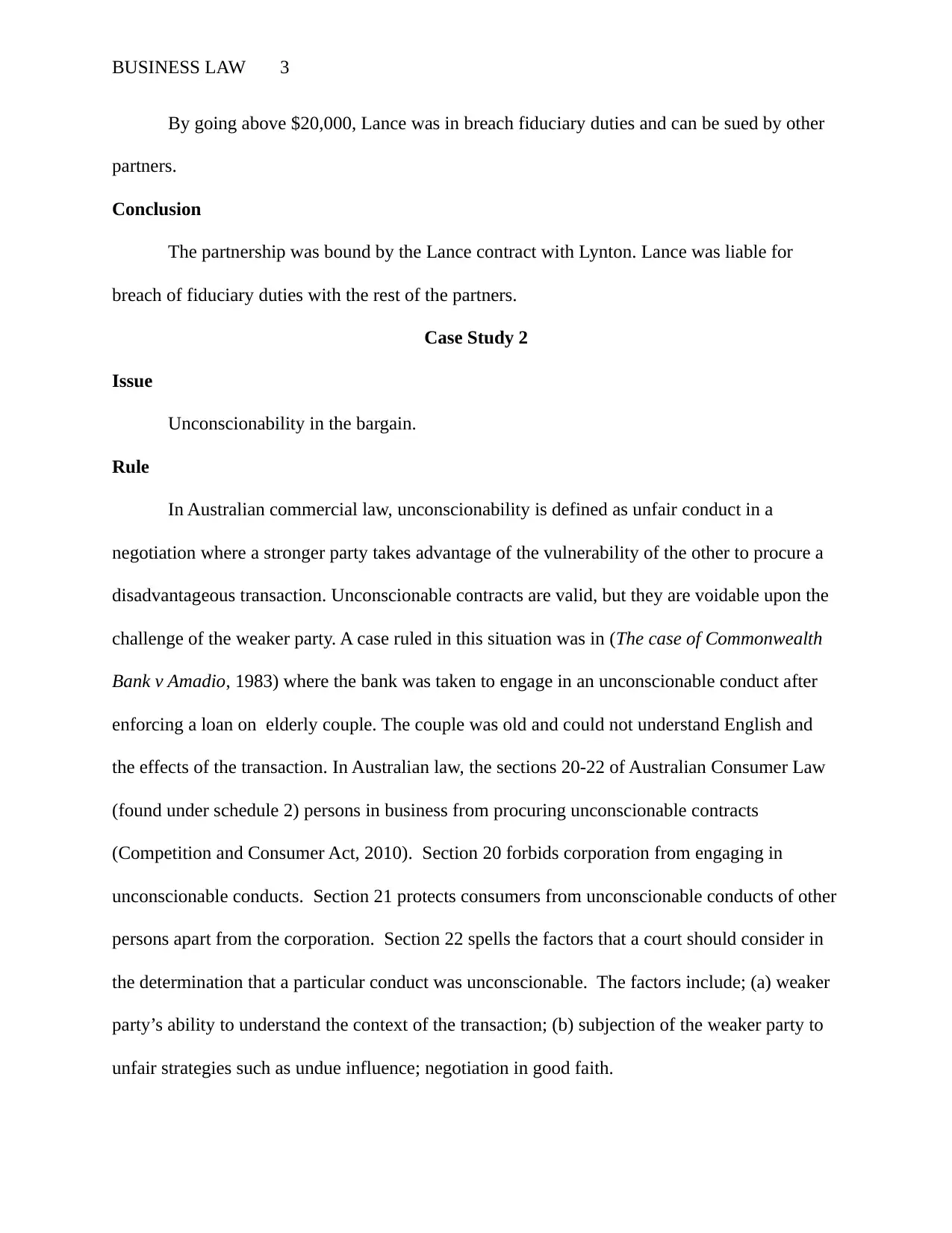
BUSINESS LAW 3
By going above $20,000, Lance was in breach fiduciary duties and can be sued by other
partners.
Conclusion
The partnership was bound by the Lance contract with Lynton. Lance was liable for
breach of fiduciary duties with the rest of the partners.
Case Study 2
Issue
Unconscionability in the bargain.
Rule
In Australian commercial law, unconscionability is defined as unfair conduct in a
negotiation where a stronger party takes advantage of the vulnerability of the other to procure a
disadvantageous transaction. Unconscionable contracts are valid, but they are voidable upon the
challenge of the weaker party. A case ruled in this situation was in (The case of Commonwealth
Bank v Amadio, 1983) where the bank was taken to engage in an unconscionable conduct after
enforcing a loan on elderly couple. The couple was old and could not understand English and
the effects of the transaction. In Australian law, the sections 20-22 of Australian Consumer Law
(found under schedule 2) persons in business from procuring unconscionable contracts
(Competition and Consumer Act, 2010). Section 20 forbids corporation from engaging in
unconscionable conducts. Section 21 protects consumers from unconscionable conducts of other
persons apart from the corporation. Section 22 spells the factors that a court should consider in
the determination that a particular conduct was unconscionable. The factors include; (a) weaker
party’s ability to understand the context of the transaction; (b) subjection of the weaker party to
unfair strategies such as undue influence; negotiation in good faith.
By going above $20,000, Lance was in breach fiduciary duties and can be sued by other
partners.
Conclusion
The partnership was bound by the Lance contract with Lynton. Lance was liable for
breach of fiduciary duties with the rest of the partners.
Case Study 2
Issue
Unconscionability in the bargain.
Rule
In Australian commercial law, unconscionability is defined as unfair conduct in a
negotiation where a stronger party takes advantage of the vulnerability of the other to procure a
disadvantageous transaction. Unconscionable contracts are valid, but they are voidable upon the
challenge of the weaker party. A case ruled in this situation was in (The case of Commonwealth
Bank v Amadio, 1983) where the bank was taken to engage in an unconscionable conduct after
enforcing a loan on elderly couple. The couple was old and could not understand English and
the effects of the transaction. In Australian law, the sections 20-22 of Australian Consumer Law
(found under schedule 2) persons in business from procuring unconscionable contracts
(Competition and Consumer Act, 2010). Section 20 forbids corporation from engaging in
unconscionable conducts. Section 21 protects consumers from unconscionable conducts of other
persons apart from the corporation. Section 22 spells the factors that a court should consider in
the determination that a particular conduct was unconscionable. The factors include; (a) weaker
party’s ability to understand the context of the transaction; (b) subjection of the weaker party to
unfair strategies such as undue influence; negotiation in good faith.
Paraphrase This Document
Need a fresh take? Get an instant paraphrase of this document with our AI Paraphraser
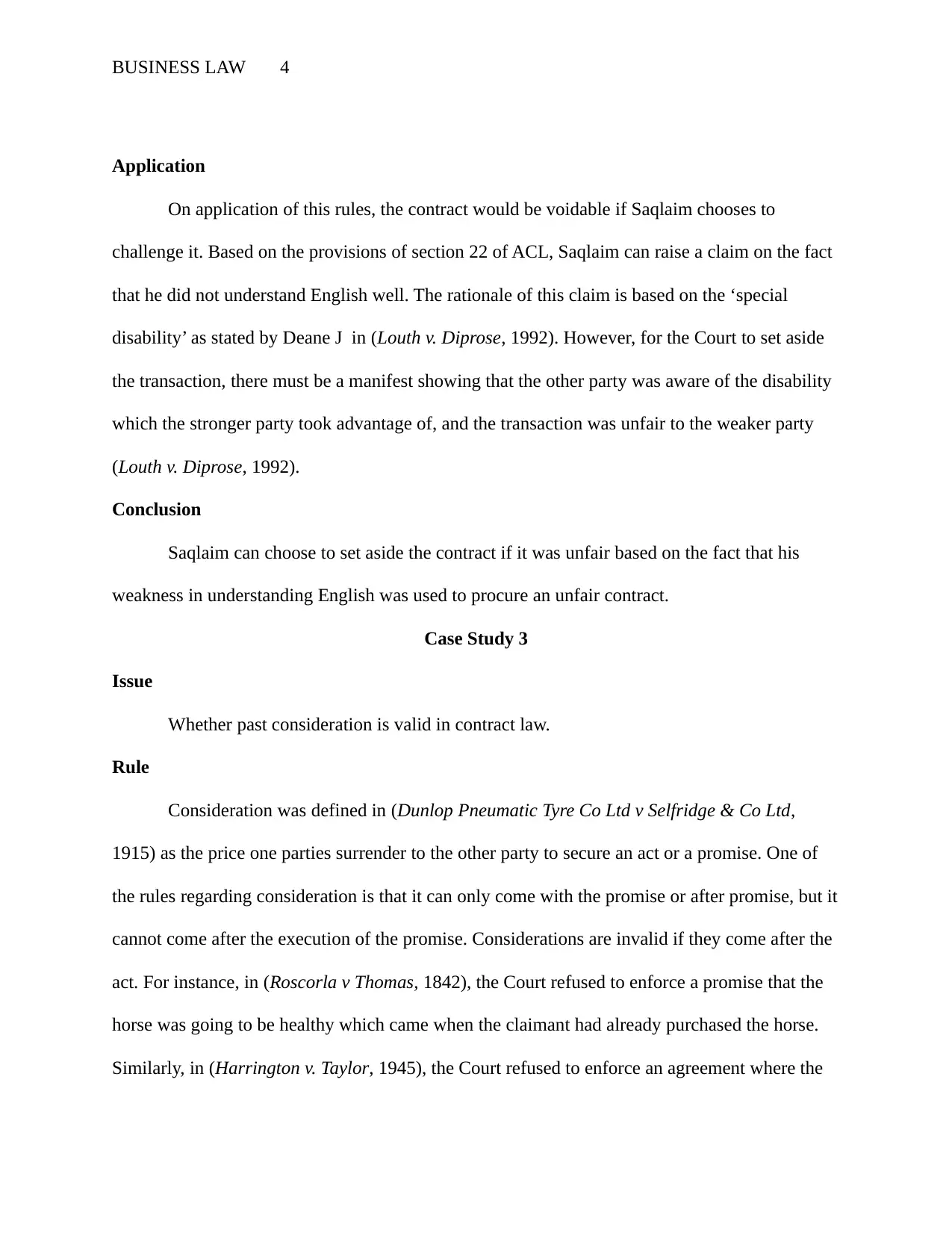
BUSINESS LAW 4
Application
On application of this rules, the contract would be voidable if Saqlaim chooses to
challenge it. Based on the provisions of section 22 of ACL, Saqlaim can raise a claim on the fact
that he did not understand English well. The rationale of this claim is based on the ‘special
disability’ as stated by Deane J in (Louth v. Diprose, 1992). However, for the Court to set aside
the transaction, there must be a manifest showing that the other party was aware of the disability
which the stronger party took advantage of, and the transaction was unfair to the weaker party
(Louth v. Diprose, 1992).
Conclusion
Saqlaim can choose to set aside the contract if it was unfair based on the fact that his
weakness in understanding English was used to procure an unfair contract.
Case Study 3
Issue
Whether past consideration is valid in contract law.
Rule
Consideration was defined in (Dunlop Pneumatic Tyre Co Ltd v Selfridge & Co Ltd,
1915) as the price one parties surrender to the other party to secure an act or a promise. One of
the rules regarding consideration is that it can only come with the promise or after promise, but it
cannot come after the execution of the promise. Considerations are invalid if they come after the
act. For instance, in (Roscorla v Thomas, 1842), the Court refused to enforce a promise that the
horse was going to be healthy which came when the claimant had already purchased the horse.
Similarly, in (Harrington v. Taylor, 1945), the Court refused to enforce an agreement where the
Application
On application of this rules, the contract would be voidable if Saqlaim chooses to
challenge it. Based on the provisions of section 22 of ACL, Saqlaim can raise a claim on the fact
that he did not understand English well. The rationale of this claim is based on the ‘special
disability’ as stated by Deane J in (Louth v. Diprose, 1992). However, for the Court to set aside
the transaction, there must be a manifest showing that the other party was aware of the disability
which the stronger party took advantage of, and the transaction was unfair to the weaker party
(Louth v. Diprose, 1992).
Conclusion
Saqlaim can choose to set aside the contract if it was unfair based on the fact that his
weakness in understanding English was used to procure an unfair contract.
Case Study 3
Issue
Whether past consideration is valid in contract law.
Rule
Consideration was defined in (Dunlop Pneumatic Tyre Co Ltd v Selfridge & Co Ltd,
1915) as the price one parties surrender to the other party to secure an act or a promise. One of
the rules regarding consideration is that it can only come with the promise or after promise, but it
cannot come after the execution of the promise. Considerations are invalid if they come after the
act. For instance, in (Roscorla v Thomas, 1842), the Court refused to enforce a promise that the
horse was going to be healthy which came when the claimant had already purchased the horse.
Similarly, in (Harrington v. Taylor, 1945), the Court refused to enforce an agreement where the
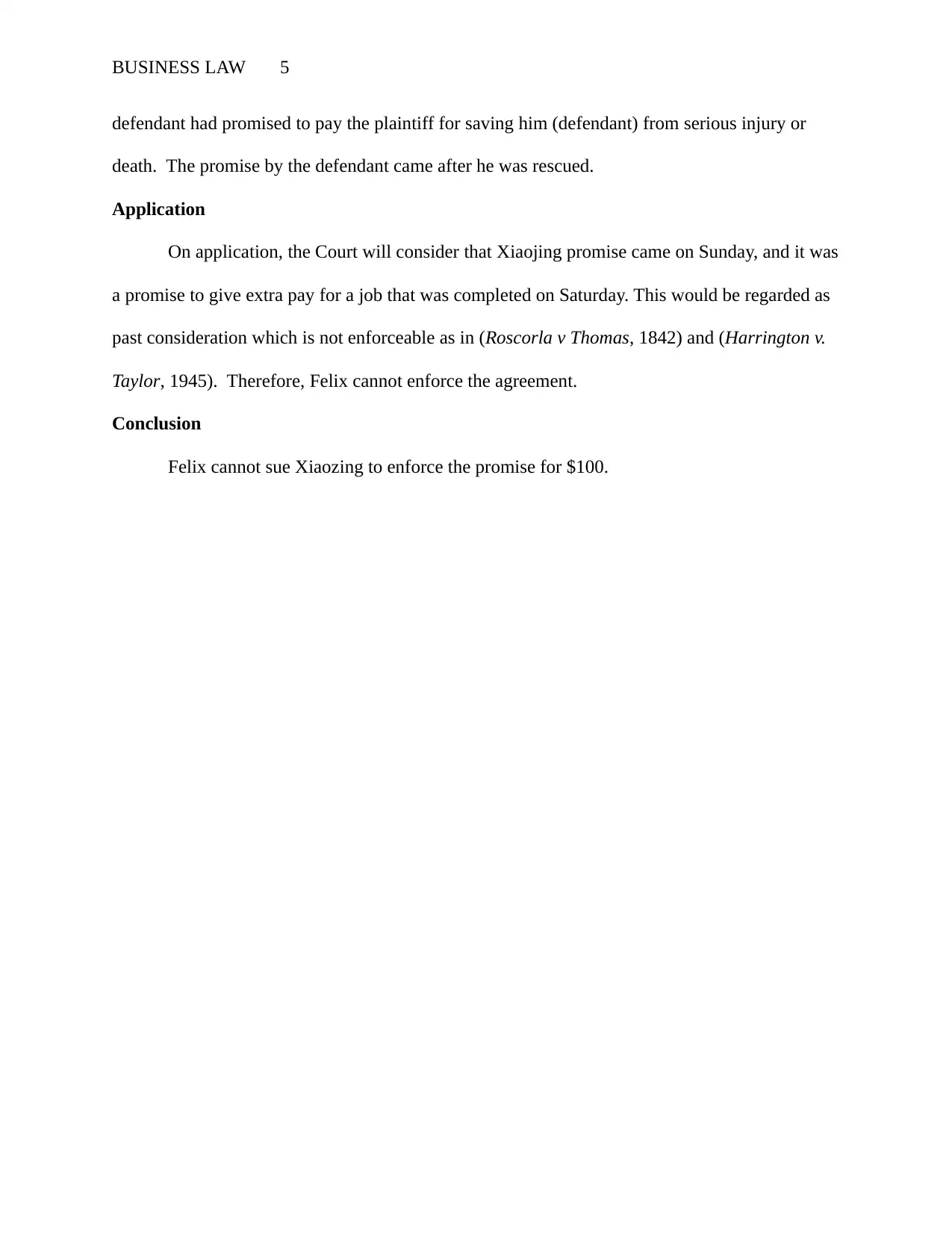
BUSINESS LAW 5
defendant had promised to pay the plaintiff for saving him (defendant) from serious injury or
death. The promise by the defendant came after he was rescued.
Application
On application, the Court will consider that Xiaojing promise came on Sunday, and it was
a promise to give extra pay for a job that was completed on Saturday. This would be regarded as
past consideration which is not enforceable as in (Roscorla v Thomas, 1842) and (Harrington v.
Taylor, 1945). Therefore, Felix cannot enforce the agreement.
Conclusion
Felix cannot sue Xiaozing to enforce the promise for $100.
defendant had promised to pay the plaintiff for saving him (defendant) from serious injury or
death. The promise by the defendant came after he was rescued.
Application
On application, the Court will consider that Xiaojing promise came on Sunday, and it was
a promise to give extra pay for a job that was completed on Saturday. This would be regarded as
past consideration which is not enforceable as in (Roscorla v Thomas, 1842) and (Harrington v.
Taylor, 1945). Therefore, Felix cannot enforce the agreement.
Conclusion
Felix cannot sue Xiaozing to enforce the promise for $100.
⊘ This is a preview!⊘
Do you want full access?
Subscribe today to unlock all pages.

Trusted by 1+ million students worldwide
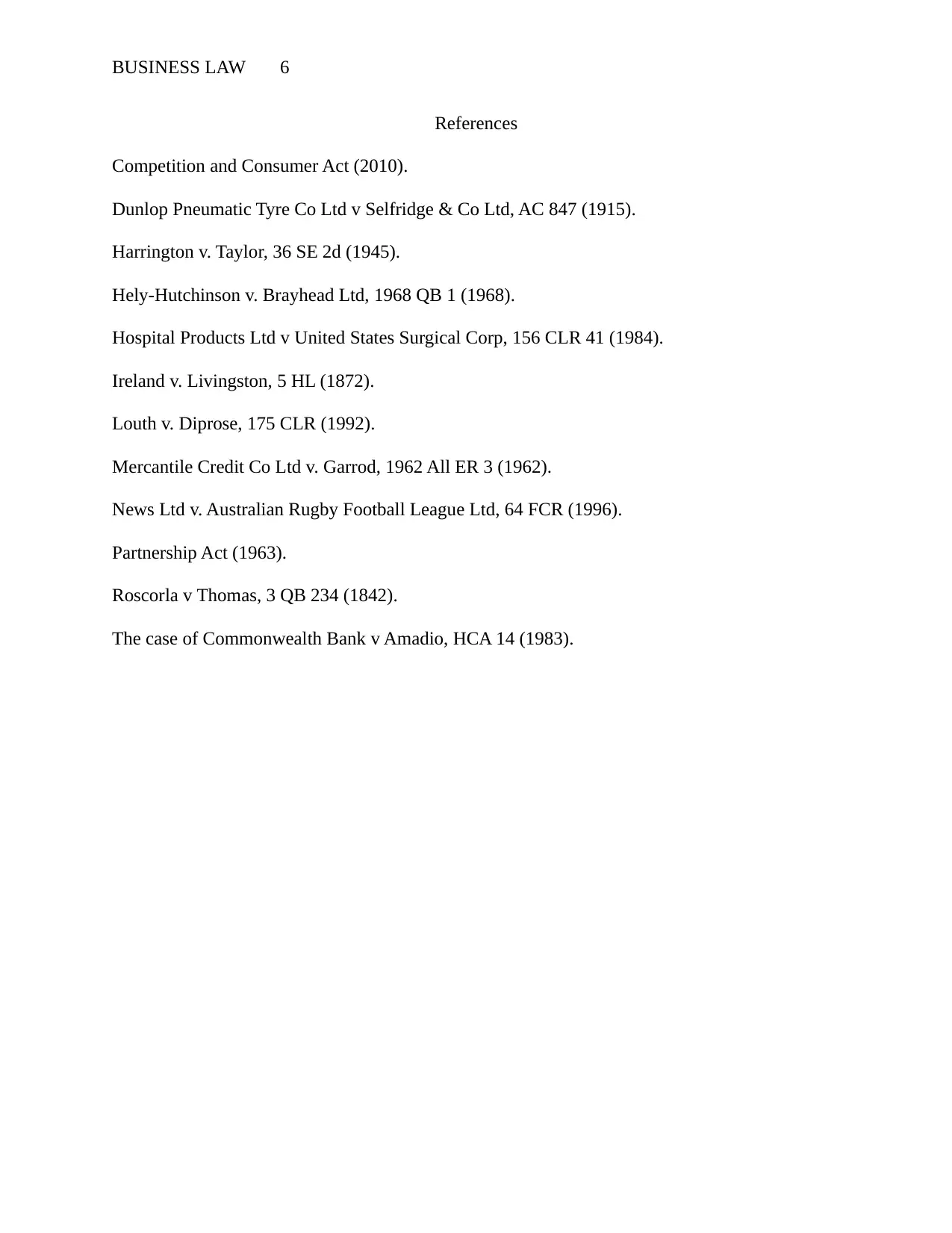
BUSINESS LAW 6
References
Competition and Consumer Act (2010).
Dunlop Pneumatic Tyre Co Ltd v Selfridge & Co Ltd, AC 847 (1915).
Harrington v. Taylor, 36 SE 2d (1945).
Hely-Hutchinson v. Brayhead Ltd, 1968 QB 1 (1968).
Hospital Products Ltd v United States Surgical Corp, 156 CLR 41 (1984).
Ireland v. Livingston, 5 HL (1872).
Louth v. Diprose, 175 CLR (1992).
Mercantile Credit Co Ltd v. Garrod, 1962 All ER 3 (1962).
News Ltd v. Australian Rugby Football League Ltd, 64 FCR (1996).
Partnership Act (1963).
Roscorla v Thomas, 3 QB 234 (1842).
The case of Commonwealth Bank v Amadio, HCA 14 (1983).
References
Competition and Consumer Act (2010).
Dunlop Pneumatic Tyre Co Ltd v Selfridge & Co Ltd, AC 847 (1915).
Harrington v. Taylor, 36 SE 2d (1945).
Hely-Hutchinson v. Brayhead Ltd, 1968 QB 1 (1968).
Hospital Products Ltd v United States Surgical Corp, 156 CLR 41 (1984).
Ireland v. Livingston, 5 HL (1872).
Louth v. Diprose, 175 CLR (1992).
Mercantile Credit Co Ltd v. Garrod, 1962 All ER 3 (1962).
News Ltd v. Australian Rugby Football League Ltd, 64 FCR (1996).
Partnership Act (1963).
Roscorla v Thomas, 3 QB 234 (1842).
The case of Commonwealth Bank v Amadio, HCA 14 (1983).
1 out of 7
Related Documents
Your All-in-One AI-Powered Toolkit for Academic Success.
+13062052269
info@desklib.com
Available 24*7 on WhatsApp / Email
![[object Object]](/_next/static/media/star-bottom.7253800d.svg)
Unlock your academic potential
Copyright © 2020–2025 A2Z Services. All Rights Reserved. Developed and managed by ZUCOL.




